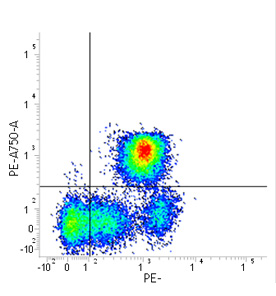CD52 Marker Antibodies

- On This Page
- Overview
- Anti-human CD52 clones
- CD52 antibody image by application
- CD52 antibodies
- References
Overview
CD52 is a small (25-29 kDa), heavily glycosylated peptide that is bound to the cell surface membrane by a GPI link. Also known as CAMPATH-1, CD52 is expressed by B and T cells, monocytes, macrophages and eosinophils, and also expressed in the male reproductive tract and on malignant lymphocytes (Hale 1995).
The exact role of CD52 remains unclear however it is thought to be a regulatory molecule for the inhibition of T cell activation by binding to Siglec-10 (Bandala-Sanchez et al. 2013) and a co-stimulatory molecule for the induction of CD4+ regulatory T cells (Toh et al. 2013).
Owing to the prevalence and location of CD52 and that depletion of CD52 has been shown to induce antibody dependent cellular cytotoxicity, and possibly complement dependent cytotoxicity (Zent et al. 2008 and Hu et al. 2009), CD52 is an ideal target for therapeutic agents involved in the treatment of B cell malignancies and autoimmune diseases including rheumatoid arthritis and multiple sclerosis.
Anti-human CD52 clones
- Clone HI186 antibody (MCA6140), recommended application is flow cytometry and immunohistochemistry – paraffin sections
- Clone YTH34.5 antibody (MCA1642), recommended applications include; cytotoxic assay, ELISA, flow cytometry, immunohistochemistry – frozen, immunohistochemistry – paraffin sections, immunoprecipitation, resin immunohistological sections and western blotting
- Clone YTH66.9HL antibody (MCA349R) recommended applications include; cytotoxic assay, flow cytometry, immunohistochemistry – frozen and western blotting
- Clone Campath-1H antibody (MCA6101), recommended application is ELISA
CD52 antibody image by application
CD52 Antibodies
| Description | Target | Format | Clone | Applications | Citations | Code |
|---|
Searching for your antibody of choice is made easy by the use of the sophisticated filter table, which allows you to select for specific antibody parameters. If you are unable to find your desired antibody simply contact us as we are adding new product all the time and we will be happy to help advise you.
References
- Bandala-Sanchez E et al. (2013). T cell regulation mediated by interaction of soluble CD52 with the inhibitory receptor Siglec-10. Nat Immunol. 14, 741-748.
- Hale G. 1995. Synthetic peptide mimotope of CAMPATH-1 (CD52) antigen, a small glycosylphosphatidylinositol-anchored glycoprotein. Immunotechnology. 1, 175-187.
- Hu Y et al. (2009). Investigation of the mechanism of action of alemtuzumab in a human CD52 transgenic mouse model. Immunology. Oct doi: 10.1111/j.1365-2567.2009.03115.x
- Toh BH et al. (2013). Immune regulation by CD52-expressing CD4 T cells. Cell Mol Immunol. 10, 379-382
- Zent CS et al. (2008). Direct and complement dependent cytotoxicity in CLL cells from patients with high-risk early-intermediate stage chronic lymphocytic leukemia (CLL) treated with alemtuzumab and rituximab. Leuk Res. Dec doi: 10.1016/j.leukres.2008.05.014






